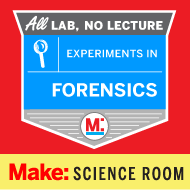
Different dyes affect different fibers differently. A dye that strongly tints animal fibers may impart little or no color to vegetable fibers or artificial fibers, and vice versa. This differential effect of dyes on fibers is sometimes used by forensic scientists to classify questioned fibers.
Testfabrics, Inc. (www.testfabrics.com) produces a series of standard Testfabrics Identification Stains (TIS), which are mixtures of dyes of different colors chosen for their differing effects on various types of fibers. In use, one or more TIS solutions are used to dye a white or previously dye-stripped questioned fiber specimen as well as a series of known fiber specimens. When the dyeing is complete, the specimens are rinsed and dried, after which the questioned specimen can be compared against the knowns to identify the questioned fiber. Using multiple TIS solutions makes it easier to discriminate questioned fibers, because it offers multiple points of comparison.
In this lab session, we’ll use TIS #1, which is designed to discriminate various natural fibers, and TIS #3A, which is designed to discriminate artificial fibers. Despite these somewhat arbitrary distinctions, TIS #1 stains some artificial fibers and TIS #3A stains some natural fibers, so using both dyes on both types of fibers provides additional information that is useful for discriminating either type of fiber.
For our series of known fibers, we’ll use strips of Testfabrics, Inc. Multifiber Fabric #43, which includes specimens of spun diacetate, SEF (modacrylic), filament triacetate, bleached cotton, Creslan 61 (acrylic), Dacron 54 (polyester), Dacron 64 (polyester), Nylon 66 (polyamide), Orlon 75 (acrylic), spun silk, polypropylene (polyolefin), viscose (rayon), and worsted wool. We’ll stain one multi-fiber strip with TIS #1 and another with TIS #3A and then compare the results against questioned fiber specimens that have been stained in one or the other TIS solution to determine the type of fiber of the questioned specimen.
Required Equipment and Supplies
- goggles, gloves, and protective clothing
- balance and weighing papers
- hotplate
- beaker, 150 mL (2)
- graduated cylinder, 10 mL
- graduated cylinder, 100 mL
- beaker tongs
- forceps or crucible tongs
- hair dryer or clothing iron
- clock or watch
- paper towels
- distilled white vinegar
- distilled or deionized water
- TIS #1 solution, 1% (see Substitutions and Modifications)
- TIS #3A solution, 0.05% (see Substitutions and Modifications)
- Multifiber Fabric #43 strip
- questioned fabric specimens (see Substitutions and Modifications)
The Maker Shed carries a variety of chemistry supplies and equipment. Check out the Science Room section to see what’s currently available.
 CAUTIONS
CAUTIONS
This lab session uses boiling liquids, which must be handled carefully to avoid burns. The TIS stains also stain skin and clothing. Wear splash goggles, gloves, and protective clothing, and use tongs to handle the specimens.
Substitutions and Modifications
- To make up the TIS #1 stain solution, dissolve 1.0 g of TIS #1 powder in 100 mL of warm distilled or deionized water.
- To make up the TIS #3A stain solution, dissolve 0.05 g of TIS #3A powder in 100 mL of warm distilled or deionized water. After the powder dissolves, add 2 mL of distilled white vinegar per 100 mL of stain solution.
- Dye tests are used only with white or off-white fabrics. If one or more of your questioned specimens is dyed, strip the dye(s) using the procedures described in the preceding lab session before you dye-test those specimens.
Procedure
- If you have not done so already, put on your goggles, gloves, and protective clothing.
- Transfer 100 mL of TIS #1 solution to one beaker and 100 mL of TIS #3A solution to the second beaker.
- Place both beakers on the hotplate and bring them to a gentle boil. After they come to a boil, reduce heat to keep them near boiling.
- Using a stirring rod, forceps, or crucible tongs, immerse a narrow (~ 1 cm) strip of Multifiber Fabric #43 and one of your questioned specimens in each beaker.
- Allow the specimens to remain in the beakers for five minutes, making sure that they remain submerged.
- After five minutes, use the tongs to remove the specimens from the beakers. Rinse the TIS #1 specimens thoroughly in cold running tap water and the TIS #3A specimens in hot running tap water.
- When all specimens are thoroughly rinsed, place each specimen on a paper towel and use a second paper towel to blot the specimens dry.
- Use the hair dryer or clothing iron to finish drying the specimens and set the dyes. (If you use an iron, place the specimens between two layers of paper towels rather than putting the specimens in direct contact with the iron.)
- For both stains, compare each of the questioned specimens with the Multifiber Fabric #43 known specimens and record your observations in your lab notebook.
- Mount and label the specimens in your lab notebook.
Figure 6-17 shows specimens of Multifiber Fabric #43 before dyeing, dyed with TIS #1 stain, and dyed with TIS #3A stain.

Figure 6-17. Multifiber Fabric #43 specimens before dyeing (left), dyed with TIS #1 stain (center), and dyed with TIS #3A stain
Review Questions
Q1: Given the availability of burning and solubility tests, what value (if any) do fabric dyeing tests have, and why?





Cottton is best solution for everything:
Nylon 66 (polyamide), Orlon 75 (acrylic), spun silk, polypropylene (polyolefin), viscose (rayon), and worsted wool.
[…] forensics this is one of the things they use to determine what kind of fibers fabrics are made of (MAKE Forensics Lab). Acid dyes like to bond to protein fibers like wool and silk. (And nylon curiously enough.) They […]
[…] Download Plan More @ makezine.com […]